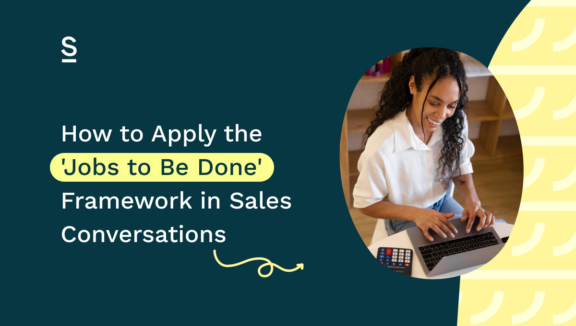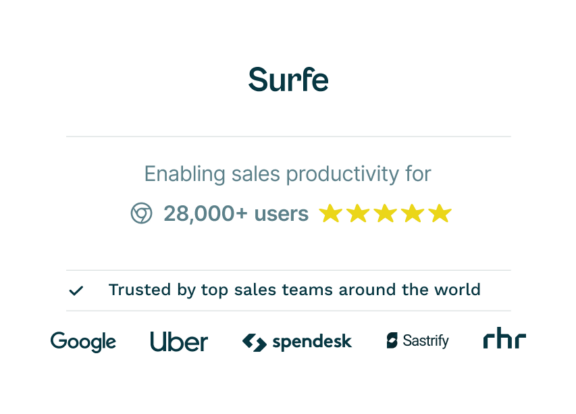How to Apply the ‘Jobs to Be Done’ Framework in Sales Conversations

Get your imagination hat on for a second.
Imagine you need to purchase a new software for your business.
(Buying instead of selling, for once – how the tables have turned).
You’re hit with two messages from competing salespeople. One salesperson starts talking about all the cool, innovative features their product has. The other has a much simpler message: that their product will solve your problems.
If you’d rather go with the second salesperson, you’re not alone: 91% of users will purchase from businesses that offer relevant recommendations to them.
As you know, understanding customer needs in sales is really, really important. So important, in fact, that success often hinges on identifying the core challenge(s) a customer needs to solve.
This is basically the principle behind the Jobs to Be Done (JTBD) framework in a nutshell. Customers don’t purchase features. Instead, they “hire” products or services to accomplish specific “jobs”, or in other words, solve their problems.
Applying a JTBD framework to sales conversations will change your message from product-pushing to solution-driven – and take your customer understanding to the next level. Let’s dig in:
- Understanding the Jobs To Be Done Framework in Sales
- Identifying the Customer’s “Job” in Sales Conversations
- Applying Jobs To Be Done Insights to Craft Tailored Solutions
- Enhancing Long-Term Customer Relationships Through Jobs To Be Done
Off with the imagination hat, on with the Jobs To Be Done hat. Let’s go 👇
Understanding the Jobs To Be Done Framework in Sales
Understanding the Jobs To Be Done framework is pretty simple. Basically, you need to think of your customers as not buying a product – instead, they’re buying a solution to a problem or a route to fulfilling an objective.
These outcomes might look like:
- Accomplishing a task: figuring out how to integrate a new workflow into their operations, or responding to a new market trend
- Achieving a goal: hitting a target, or improving a certain metric
- Resolving a problem: reducing a metric, or making a complicated task easier to do
- Making progress in their lives: impressing their boss or reducing stress in their working day
To use a simple example, users don’t use Uber or Bolt because they like the app. They “hire” Uber or Bolt to get them where they need to go, without having to drive themselves or find parking.
In a work context, using a Jobs To Be Done framework means you’re focussing on outcomes rather than features. You’re showing customers how you’re going to solve their problems instead of just focusing on product specs.
Got it? Let’s find out how to apply the Jobs To Be Done framework to your conversations.
Identifying the Customer’s “Job” in Sales Conversations
Identifying the customer’s “job” in a sales conversation is pretty simple when you know how. Really, it just comes down to asking the right questions – you’re probably already pretty good at as a sales pro.
You can steer the conversation toward uncovering the customer’s goals and needs by asking open-ended questions that don’t imply an answer.
For example, “You must be pretty busy in your role, right?” directs the prospect toward talking about how much time they need to save. This question gets the prospect to confirm your assumption that they feel like they’re too busy – while in fact, they might be really busy but not that concerned about it.
If you asked “What are the main challenges you face in your role today?” instead, they might have answered something totally different – that you didn’t even realize was a challenge for them. Sneaky, right?
Super valuable tip: if your prospect gives a loooong list of problems in response, follow this question up with “Can you rank these challenges?” to find out what they really care about.
Other open-ended questions include:
- How would you describe your role? What are your responsibilities?
- Who else cares about the outcome of this project?
- How are you looking to solve this problem?
- What worries you about your current solution?
- What would you need from your supplier?
Listening for Cues
Asking the above questions is only the first step. Your role in this conversation is to tease out further, deeper insights from your prospect. Do this by:
- Listening for differences in their tone, or the speed at which they’re talking
- Say you don’t understand or need more clarification to get more details and context
- Lean into pauses. If they give a short answer to a question, don’t assume it’s because they don’t have to say. It might be because they have too much to say – give them a chance to articulate their thoughts
- If they say something interesting, repeat it back to them to see what other details they give
You’ll notice here that the key is listening actively, and approaching the conversation from a place of empathy rather than a place of wanting to take their money. Let’s take a closer look at that.
Common Mistakes to Avoid
The biggest mistake when applying a Jobs To Be Done Framework to your sales conversations is talking too much. The danger here is that you slip into a product pitch – as you’re clearly not going to be able to base your conversation around insights you haven’t found out yet.
Think understanding-first and keep encouraging your prospect to speak as much as possible top of mind – you won’t go too far wrong.
Applying Jobs To Be Done Insights to Craft Tailored Solutions
Ok, so you’ve found out some really juicy stuff about your prospect. Maybe they actually are drowning in admin, or maybe they’re super keen to impress their boss by driving a certain metric skywards.
Btw – it’s useful here to have someone else sit in on the call or check out the recording highlights if possible. They might pick up on another insight for you.
Whatever you find, the next step is to use these insights to craft a solution for your prospect.
For example, you might say “I understand that you’re struggling to keep on top of the admin of [task]. That’s exactly why we built [product], as it saves an average of four hours of admin time a week for customers.”
See how here you haven’t actually explained how or gone into much detail about what the product does yet. Instead, you’re leading with how you can help the customer achieve their goals.
Showing Value in the Customer’s Language
It’s really important here to show the value of your product in the customer’s language, to make sure that it resonates. For example, a company might say “Our product enhances team productivity and reduces manual interventions”, whereas a customer might say “It saves us time and makes the team more efficient”.
Example of a Jobs To Be Done-based Sales Pitch
Let’s say you have a product that gathers really, really excellent data for your customers to use. You might be tempted to talk about “Real-time data analytics” and “Actionable insights”.
Instead, focus on:
- Your customer quickly being able to see what’s happening
- Your customer making faster, better decisions
- Your customer feeling confident in the data they’re working with
Got it? Good.
Enhancing Long-Term Customer Relationships Through Jobs To Be Done
Implement a Jobs To Be Done Framework into your initial sales conversations, and you should have increased prospect interest and speedier sales cycles. Pretty neat, right?
Those aren’t the only benefits, though. The Jobs To Be Done Framework is also a great tool for building long-term relationships with your customers – and getting them to stick around for longer, too.
Apply the framework throughout your relationship with your customer, and you’ll get to keep track of their jobs changing – and in turn, make sure they’re getting the best out of your product or service.
Happy customers = higher retention rates. After all, 80% of customers who switch to a competitor do so because they feel their current solution doesn’t speak to their needs and pain points.
Continuous Job Discovery
Keep track of these changing jobs by encouraging regular conversations with customers, particularly during moments of growth or change for their business.
These conversations are gold dust for anyone with a hand in the growth function – Sales, Customer Success, Marketing, and Product.
KPIs to Track
As always, you don’t want to be doing a task without an idea of whether it’s actually having an impact. The following metrics can give you an idea of whether these conversations are doing what they’re meant to do:
Customer Satisfaction (CSAT): CSAT measures how happy customers are by using a simple rating system, like 1-5 stars
Retention Rates: Retention rate tracks the percentage of customers who continue to use a product or service over a specific period, indicating customer loyalty
Upsell Success: Upsell success measures how often existing customers purchase higher-tier or additional products or services beyond their original purchase.
We’re almost there – let’s quickly run through avoiding any snags or potential pitfalls.
Challenges and Tips for Implementing Jobs To Be Done in Sales Teams
We’re fully aware that implementing Jobs To Be Done into your sales processes can be hard – particularly if it’s a big departure from what you were working on already.
It’s really common for sales teams to initially show a bit of resistance to change – which is where some good old-fashioned change management comes in.
You’ll want to start by properly explaining what a Jobs To Be Done framework is (good job we’ve done that for you 😉) and use company data to explain why you’re making the change. Take the time to properly train and coach your teams on the Jobs To Be Done framework – that means running role-playing exercises, demonstrating real-world examples, and having them listen in on your own calls.
Make it clear that implementing Jobs To Be Done frameworks takes patience and practice – you shouldn’t expect anyone to nail it on the first go. No, not even your star players.
Let’s Wrap It Up!
That Jobs To Be Done hat looks good on you!
By now, you should understand that introducing the framework is going to help you, and your team, become more customer-centric and solution-oriented. As a result, you’ll experience easier sales cycles and enjoy longer-term, more fruitful relationships with your customers.
Get your team started, track the difference in engagement and outcomes – and don’t forget to let us know how it goes.

Ready to start ‘jobs to be done-ing’ everyone in sight?
First you need some willing participants. Surfe will help you find them – try it for free.
FAQs About Applying the ‘Jobs to Be Done’ Framework in Sales Conversations
What Are the Key Principles of the ‘Jobs to Be Done’ Framework for Sales Teams?
The key thing to remember about a jobs to be done (JTBD) framework is that you’re changing your selling approach from product or feature-focussed to problem-solving. It’s based on the principle that customers don’t buy products – instead, they buy solutions to problems or ways to achieve an outcome. By focusing on outcomes rather than features, you’re giving your prospects a personalized sales experience.
How to Identify Customer Jobs in Sales Conversations Using JTBD?
Key ways to identify customer jobs using a JTBD framework include:
- Asking neutral, open-ended questions: you don’t want to influence a prospect’s response in any way, so make sure your questions are neutral and make space for them to elaborate
- Listening out for cues: keep an ear out for changes in tone or pace, or a silence that indicates they’re thinking
- Digging deeper: ask for further clarification or repeat what they’ve said to encourage them to talk more
What Common Mistakes to Avoid When Applying the ‘Jobs to Be Done’ Framework in Sales?
Common mistakes involve talking too much, which will naturally mean you start speaking about your product and its features instead of providing a personalized experience. You should also make sure you’re practicing active listening, instead of hearing what you want to hear.
How Can the ‘Jobs to Be Done’ Approach Improve Sales Effectiveness?
JTBD can make your sales cycles faster and improve your relationships with your prospects. This positive note can continue throughout the customer relationship if you continue to run these sessions, as you’ll stay aware of customers’ changing jobs and make sure your product or service is meeting their needs.


